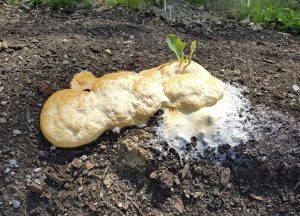Slime Molds
Pest Management Fact Sheet #5065
Developed by Alicyn Smart, Assistant Extension Professor & Extension Plant Pathologist, Matthew Wallhead, Extension Ornamental Horticulture Specialist and Assistant Professor of Horticulture, University of Maine Cooperative Extension, and Nathan Andrews.
For information about UMaine Extension programs and resources, visit extension.umaine.edu.
Find more of our publications and books at extension.umaine.edu/publications/.
Other Name: Scrambled egg fungus
Pathogen: Taxonomic group Myxomycota
Introduction

Slime molds are organisms within the taxonomic group known as Myxomycota. Slime molds are not fungi, but single celled amoeba-like organisms that create a single structure known as a plasmodium that behaves similarly to a multi-cellular organism. Plasmodia are formed during warm, moist conditions when spores germinate and the single celled organisms fuse together. As more and more cells fuse into the plasmodium, it will slowly begin to expand in size and area. When the conditions begin to dry the plasmodium becomes crusty and spores are produced beneath this hardened surface (Figure 1).
When the surface is disturbed by people, wildlife or rain, millions of spores are dispersed to a different location. Spores are viable for several years until conditions are favorable for germination. Naturally, the plasmodium will break down and will no longer be visible.
Host Plants
Most commonly found on hardwood bark mulch, dead leaves and decaying wood.
- Occasionally, slime molds can cover turf and seedlings
Symptoms and Signs
Slime molds develop during periods of warm moist weather which in Maine can range from late spring to fall. The color is variable and depending on the material they ingest and the species of the slime mold. The most common slime mold in Maine is Dog Vomit (Fuligo septica) which is a vibrant yellow that then transitions to a hardened reddish brown color when it enters the next stage in its life cycle. This transition is due to reduced moisture and/or an exhausted food source. Other slime mold species resemble fan like growth. The size and shape is also variable and dependent on environmental condition that influence the growth of the slime mold. The size can range from inches to a couple feet or more in diameter.
Management

Slime molds are harmless to most plants, pets, and for the most part humans. People with respiratory conditions might be irritated by the spores. The only pathogenic issue slime molds can cause is covering and blocking the sun out for seedlings or turf to grow (Figure 2), but even this is temporary. These organisms are saprophytic, meaning they derive nourishment from decaying organic materials, and will not attack living plants even if they are found on plants. If cosmetically slime molds are an issue, you can collect the plasmodium and throw it away. No pesticide is recommended for managing this organism.
References
Stephenson, Steven L. and Henry Stempen. Myxomycetes: A Handbook of Slime Molds. Timber Press Inc. Copywright 1994. Print.
Jensen, Sandra L. (February 2015). Slime Molds: Myxomycetes. Retrieved from Cornell University: http://plantclinic.cornell.edu/factsheets/slimemolds.pdf
WHEN USING PESTICIDES, ALWAYS FOLLOW LABEL DIRECTIONS!
Alicyn Smart, DPM
Plant Pathologist and Director of the Plant Disease Diagnostic Laboratory
University of Maine Cooperative Extension
Information in this publication is provided purely for educational purposes. No responsibility is assumed for any problems associated with the use of products or services mentioned. No endorsement of products or companies is intended, nor is criticism of unnamed products or companies implied.
© 2019
Call 800.287.0274 (in Maine), or 207.581.3188, for information on publications and program offerings from University of Maine Cooperative Extension, or visit extension.umaine.edu.
The University of Maine is an EEO/AA employer, and does not discriminate on the grounds of race, color, religion, sex, sexual orientation, transgender status, gender expression, national origin, citizenship status, age, disability, genetic information or veteran’s status in employment, education, and all other programs and activities. The following person has been designated to handle inquiries regarding non-discrimination policies: Director of Equal Opportunity, 101 North Stevens Hall, University of Maine, Orono, ME 04469-5754, 207.581.1226, TTY 711 (Maine Relay System).

